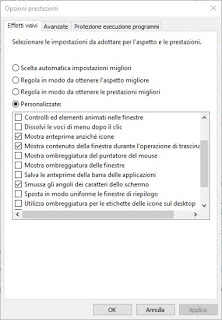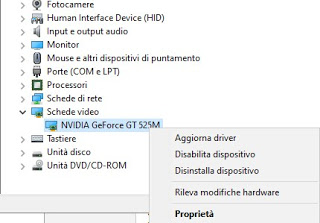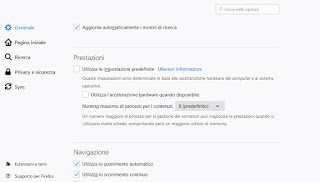 On all computers with Windows installed we have hardware acceleration, a function of the system that allows the programs and the system itself to use the capabilities of the dedicated video card or integrated video chip (on laptops) to perform tasks and improve performance. The hardware acceleration is mainly used to watch movies in high resolution but also to play video games and to use advanced graphics programs. On some computers, especially those that are slower or with hardware that is not particularly recent, hardware acceleration could lead to sudden slowdowns, up to making difficult to view streaming content.
On all computers with Windows installed we have hardware acceleration, a function of the system that allows the programs and the system itself to use the capabilities of the dedicated video card or integrated video chip (on laptops) to perform tasks and improve performance. The hardware acceleration is mainly used to watch movies in high resolution but also to play video games and to use advanced graphics programs. On some computers, especially those that are slower or with hardware that is not particularly recent, hardware acceleration could lead to sudden slowdowns, up to making difficult to view streaming content. So if we often use the computer on the Internet to watch streaming videos and notice numerous slowdowns, in this guide we'll show you how disable hardware acceleration on Windows to optimize video streaming, showing you the steps to be carried out in the system settings and within the main web browsers.
How to disable hardware acceleration on PC
In the following chapters we will show you how to disable hardware acceleration directly inside the system (not entirely applicable) and how to disable it for any modern web browser (much easier to apply).
Disable hardware acceleration on Windows 10
Windows 10 is born to take advantage of hardware acceleration, in fact all PCs that have the minimum requirements to run this system should have the acceleration already active. If we notice slowdowns when we play a video on the Internet (especially on computers with 4-5 years on their shoulders), we can improve the situation by deactivating all the graphic effects of Windows, so as to reserve the (little) hardware acceleration only for videos and programs that require it. To do this, simply right-click on the Start menu at the bottom left, click on the item System, click at the top right on the item System information and, in the new window that opens, click on the item Advanced system settings.
In the window that we will see appear on the screen, let's go into the tab advanced, press the button Settings under the section Performance and, in the tab Visual effects, we put the check mark on the item Adjust to get the best performance and, to maintain a minimum of effects for the outlines of the characters and windows, we enable (in the list below) only the items Show window contents during the drag operation, Smooth the character angles on the screen is Show previews instead of icons.
We press down on apply and then on OK. The operating system will use the hardware acceleration to the minimum, leaving the graphic resources to the programs that will require it.
If we note that even so the hardware acceleration slows down video and the execution of graphic programs, we can adopt a much more aggressive strategy to disable hardware acceleration on Windows, ie disable the video card or video chip. To do this we right click on the Start menu at the bottom left, click on Device management, let's expand the entry Video cards and we click with the right button on the elements present, so as to be able to press on the item Disable device.
Once the device is deactivated, we restart the PC for the changes to take effect. From now on Windows 10 will run in reduced graphics mode, without any type of active graphic effect and without hardware acceleration.
NOTE: some model processors have an integrated video chip inside them that can be used for graphic effects and hardware acceleration; to disable it we will have to act from the BIOS / UEFI.
Disable hardware acceleration in web browsers
If we don't want to give up the graphic effects of Windows or the video card on the computer, possiao disable hardware acceleration directly from web browsers, so from optimize streaming video viewing, which will only exploit the CPU for rendering.
On Google Chrome we can disable hardware acceleration by clicking on the three dots in the upper right corner, selecting the menu Settings, by clicking on the item advanced and scrolling until you find the item Use hardware acceleration when available, from which we must remove the check mark (we will be asked to restart the browser for the changes to take effect).
On Mozilla Firefox we can disable hardware acceleration clicking at the top right on the three horizontal lines, pressing on the menu Options and scrolling through the new window until you find the section Performance; from it we remove the check mark from the item Use the default settings and we repeat the action also on the voice Use hardware acceleration when available.
Also in this case we restart the browser to make the changes effective.
On Internet Explorer we can disable hardware acceleration opening the Start menu at the bottom left, searching for the item Internet Options, bringing us to the card advanced, search for the item Accelerated graphics and check the item Use software rendering rather than GPU rendering.
To confirm the changes, we click on the buttons apply is OK, then restart the PC.
On Edge, hardware acceleration cannot be disabled, but reducing the graphic effects or disabling the video card as seen in the previous chapter will also improve Edge's fluidity on some rather old computers.
Conclusions
Hardware acceleration can bring some problems with older computers, so it's always convenient to know the tricks to disable it from the system or from the single program (in this case the browsers). Other programs also have a hardware acceleration entry in the settings: if we notice any difficulties during the startup or use of the program, we find this entry and turn it off.
If we need to increase hardware acceleration for browsers or programs that require a lot of 3D resources, we recommend reading our guides on how to Enable GPU acceleration on Chrome and Firefox to better display sites and videos is How to dedicate RAM to the video card.
If we have a fixed PC, we can remove the old video card and choose a new one, following the suggestions proposed in our article on How to choose the video card for PC graphics.





